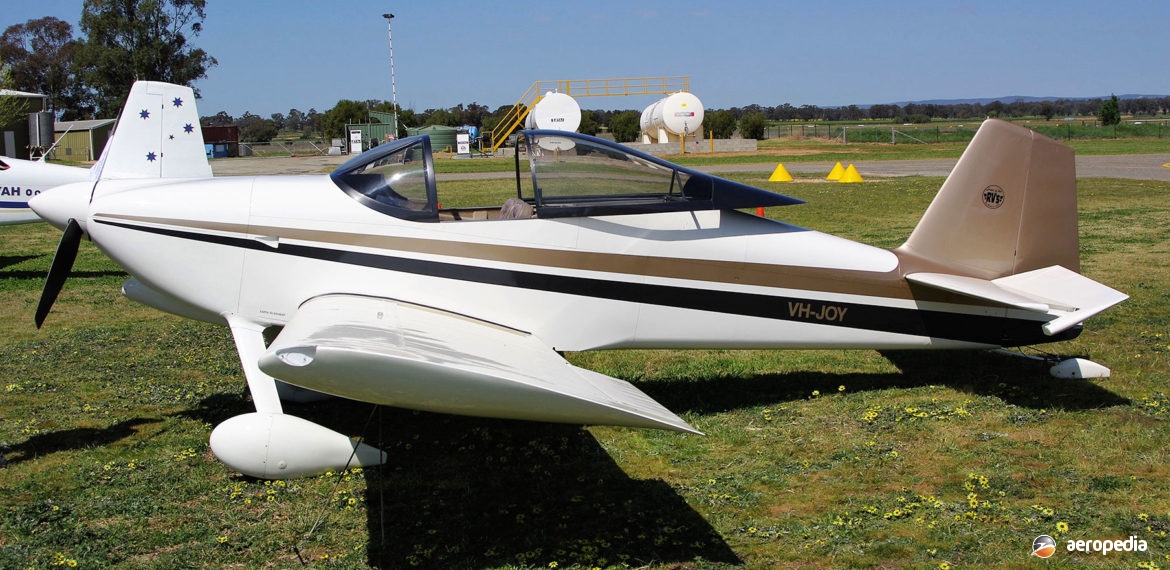Photograph:
Vans RV-6 VH-JOY (c/n W199) at Cowra, NSW in September 2008 (David C Eyre)
Country of origin:
United States of America
Description:
Two-seat sport monoplane
Power Plant:
One 119 kw (160 hp) Avco-Lycoming IO-360 four-cylinder horizontally-opposed air-cooled engine
Specifications:
- Wingspan: 7.01 m (23 ft)
- Length: 6.16 m (20 ft 2½ in)
- Height: 1.6 m (5 ft 3 in)
- Wing area: 10.22 m² (110 sq ft)
- Max speed at sea level: 323 km/h (201 mph)
- Max cruising speed at 2,440 m (8,000 ft): 307 km/h (191 mph)
- Economical cruising speed at 55% power at 2,440 m (8,000 ft): 270 km/h (168 mph)
- Stalling speed: 87 km/h (54 mph)
- Max rate of climb at sea level: 503 m/min (1,650 ft/min)
- Service ceiling: 5,945 m (19,500 ft)
- Range with max fuel at 55% power: 1,488 km (925 miles)
- Fuel capacity: 140 litres (30.8 Imp gals)
- Empty weight: 431 kg (950 lb)
- Loaded weight: 762 kg (1,600 lb)
History:
The Vans RV-6 was a development of the RV-3 and RV-4 series designed by Richard Van Grunsven, and produced by Vans Aircraft of North Plains, Oregon. The prototype of the RV-6 (N66RV) flew for the first time in June 1986. Construction of this machine began in early 1985 and it was basically similar to the RV-4 using the same basic wing spar and ribs, but the ailerons and flaps were of different lengths, and major components were not interchangeable. The main difference between the two was the wider fuselage of the RV-6 to allow for a crew with heights up to 1.96 m (6 ft 6 in). Width of the cockpit externally was 1.06 m (3 ft 6 in) and the baggage compartment behind the seats could carry up to 27.2 kg (60 lb). The RV-6 series has usually been constructed with a tailwheel undercarriage, but when it was fitted with a tricycle undercarriage it became known as the RV-6A.
The prototype had a 119 kw (160 hp) Lycoming engine fitted with a Pace Setter propeller. Performance was similar to the RV-4 and a non-retractable tailwheel or tricycle undercarriage could be installed. In 2004 the production of the RV-6 series ceased in favour of the improved RV-7 series. By the beginning of 2005 more than 150 examples of the RV-6 series had been registered in Australia, and the type has proved popular in New Zealand.
A variant known as the Air Beetle has been built in Nigeria. Fitted with a 131 kw (175 hp) engine, the prototype flew for the first time in July 1988, production aircraft replacing UK-built Scottish Aviation Bulldogs in the training role with the Nigerian Air Force.
First RV-6 registered in this region was VH-HRV (c/n N164) in January 1990, initially based at Temora, NSW but later moving to Western Australia. An example of the RV-6A has been completed and is known as the Akin SLA-1, becoming VH-AYQ.
One example in Australia has been fitted with a 4.4 litre Rover V-8 all-aluminium engine removed from a Leyland P-76 automobile. This engine had its origins in a Buick 215 cub in V-8 engine and during the rebuild new cast pistons were fitted, the intake manifold being modified to accept a Holly 350 carburettor. Max take-off rpm was 3,200 giving a propeller speed of 1,882 rpm which provided a true airspeed at 2,591 m (2,500 ft) of 287 km/h (178 mph).

